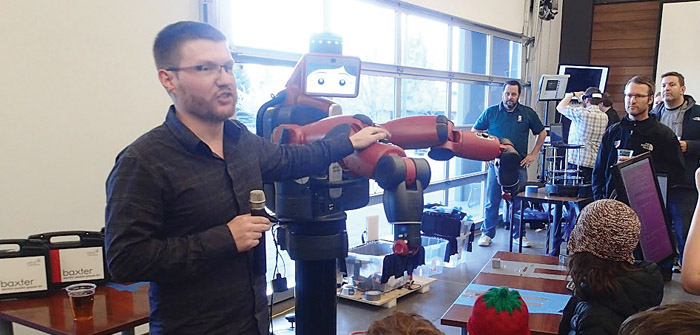Meet Mark Silliman’s Robot
It’s early evening on a Wednesday and people are slowly beginning to trickle into Stackhouse Coffee, a relatively new café hidden among the nondescript business parks across the river from the Old Mill. Any other day around this time, the young, professional baristas who staff the subjectively hip expresso bar would be wiping tables and turning chairs on end.
Tonight, however, the tables and chairs have been cleared from the space entirely, leaving copious mingling room on cold cement floors. The young, professional baristas are sticking around, standing with hands clasped behind their backs or leaning against the counter, waiting for someone to order a latte or a local beer on tap.
Tonight, Stackhouse is hosting a meeting of the Homebrew Technology Club of Bend, a group of self described “
software developers, engineers, designers and hackers” who get together over food and drinks to converse and show off projects. The name references the original Homebrew Computer Club where Steve Jobs and Steve Wozniak first demonstrated the Apple I.
Entering the cafe on this particular night, the first thing I notice is the robot. There’s no way around it: across the room from the chalk specials board on the back wall, facing into the room and backlit by the setting sun streaming through glass floor to ceiling windows, a large robot is swiveling from right to left and moving its limbs slowly along pre-planned paths. It’s arms are comparatively massive and without a doubt are packing the pounds per square inch to match, yet when Mark Silliman, it’s owner, puts his hand on one of them to duck around it, the arm comes to a direct stop.
This, he will later explain, is by design. It allows humans to work in proximity to the robot without the danger of accidental robotic knockout. Right now, the robot is mostly a toy, but at $32,000 it’s also an investment. He hopes to eventually adapt the technology to household use.
As I take my place amongst the growing crowd, Silliman is talking tech, explaining how the robot, christened Baxter by its creators and Abbe by Silliman’s daughters, can recognize humans. Abbe has 360 degree sensors to detect objects and motion as well as a camera on its “head” which acts as a more advanced cognitive tool.
The “head” consists of a tablet screen that displaces a dynamic face which moves as the other sensors detect movement. As he talks, it becomes obvious that in explaining a piece of hardware this complicated, Silliman could get very technical very quickly. Instead, however, he notices the crowd of children gathered at the front of the crowd, dumbfounded despite their parent’s scrutiny. He stops mid-sentence and, with a slight smile, asks the children, “have you guys tried this yet?”
According to Silliman, this robot’s greatest advancement is in compliance, its ability to interact with humans safely and effectively. Compliance, says Silliman, is just a fancy term meaning “it’ll stop when it touches you.” Most commercial robots have, up until this point, been massive units designed to do one thing and one thing only. Hulking automotive robots which can attach a car door in seconds have revolutionized the automotive industry. However, they’re still only useful if you’re building a car. One of Abbe’s greatest traits as the she “won’t kill you if you get in her way.”
It is this trait that allows the children, under Silliman’s direction, to operate the robot themselves. With a few easy button pushes the kids learn how to guide Abbe’s arms along paths she will remember. It’s clear that nearly anyone could teach Abbe to do many simple tasks and it is this capacity, this ability to learn and remember and perhaps eventually infer, that gives her so much potential.
The other thing that contributes to Abbe’s huge potential also contrasts it with previous robots: whereas the expensive, single purpose robots have limited application, Abbe is open source. The operating system is free and entirely open to improvement or alteration. The only limit to development is the creativity of the developers.
Another benefit of Abbe’s open source nature is the possibility of collaboration. As a community grows in tandem development, the ingenuity of the programmers and engineers can become greater than the sum of its parts. As robotic technology develops, cooperation is key.
It is this spirit of cooperation that set off the chain of events that eventually led to the meet up at Stackhouse. The crowd in attendance tonight is a diverse amalgam of the deeply involved hackers who breath silicon and speak passionately about data visualization, and wide-eyed newcomers like myself. When they started years ago, it was strictly the former. By and large, the community incubated itself.
The community operates on a system of collaboration and mutual interest. Realistically, three out of the four technologies on display tonight can likely work in tandem. The “Turtle-bot,” essentially a hyper intelligent Rumba with object recognition, is exactly the sort of base that will be used to mobilize Abbe. A laser based distance measurement system could be used in Abbe’s hands.
At one point, Silliman points out a man across the room who is working on a “flying car.” He says this with a straight face, and mentions that these cars could and likely would be autonomous. Silliman, who believes that household robots could work on a rental system not unlike a maid services, notes that eventually there may be self-controlled robots delivered by self-driving cars.
The meetings have grown as a reflection and projection of the Bend tech community at large. Just as the meetings have repeatedly expanded, changed location, and grown in format, the Bend tech community is rapidly emerging as formidable sector. In one night of mingling and chatting with a throng of tech enthusiasts of various stripes, I learn of businesses I’d never imagined, projects to be undertaken, and a vibrant culture of synthesis.
Silliman, who is also the CEO of Smartwaiver, a company producing digital liability software, expects the Bend tech industry to grow rapidly in the coming years. Bend, as frequent meetup attendee Austin Meyers puts it, is ripe for start ups. According to him, Bend is both a terrible place to find a job and a great place to create your own.
That said, Silliman cautions against creating “another San Francisco.” After all, he explains, there only needs to be one Silicon Valley. The future of the Bend tech industry and the community that goes with it parallels the futures of the technologies they works to improve. Like Abbe, we can’t know exactly what shape they will take or purpose they will serve.
According to Meyers, the bend tech sector is “information without institutions.” Right now, all we can do is recognize the potential and look forward to the future.
www.meetup.com/homebrew-technology-club
(Photo above: Mark Silliman | by Morgan Doyscher)





